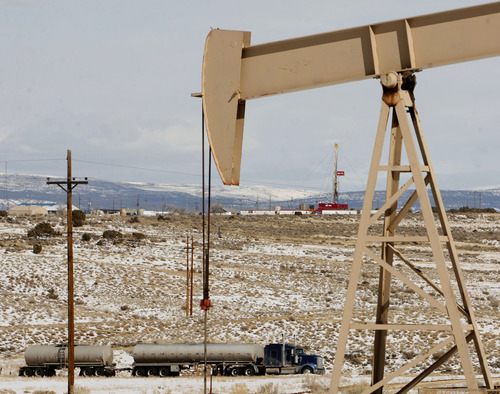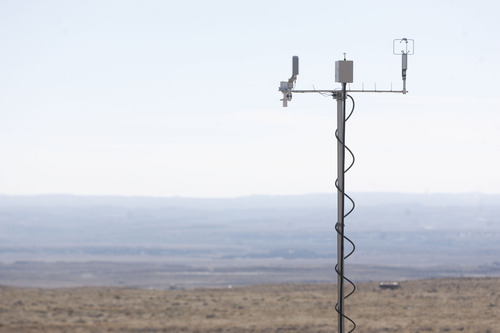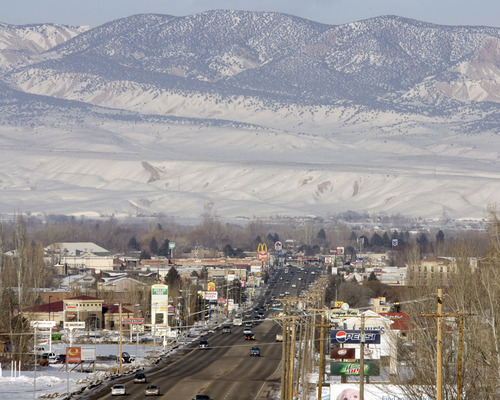This is an archived article that was published on sltrib.com in 2012, and information in the article may be outdated. It is provided only for personal research purposes and may not be reprinted.
Vernal • Oil and natural gas wells, along with cars and trucks, appear to be the key pollution culprits in sometimes making the Uinta Basin's wintertime air unhealthful.
Those are among the early findings of last winter's $5 million study to understand why rural, eastern Utah has logged some of the nation's highest ozone-pollution readings in recent years.
Although the Winter Basin Ozone Study's interim report also points to weather as an important factor, it is the first time leaders have acknowledged the major role of energy development.
"That seems to be a pretty strong link," said Brock LeBaron, who's leading the multi-agency study team in what is now expected to be a multi-year effort to help solve the winter ozone puzzle.
"I don't think anyone can be definitive at this point, but we have to make the best guess we can on possible mitigation strategies," he added, noting that the interim report suggests immediate controls on key pollutants even before all the data are in.
Ozone pollution has the biggest impact on the very young, the very old and people with heart and lung problems. It causes what's been described as a "sunburn on the lungs" and also harms otherwise healthy people.
Once considered strictly a summertime problem in big cities, winter pollution readings from the oil and gas fields of Wyoming and eastern Utah in the past eight years have shown the pollutants that create ozone — nitrogen oxides (NOX) and volatile organic compounds (VOCs) — can also cause problems in snowy, rural areas.
In the winter of 2010, pollution monitors recorded 68 days when ozone levels were higher than the EPA's health-based standard of 75 parts per billion (ppb). They showed levels reaching nearly double the federal limits in 2011.
Last year's study was mounted by the energy industry, affected counties, the Ute tribe, the EPA, the National Oceanographic and Atmospheric Administration and Utah State University's Energy Dynamics Laboratory.
But solutions aren't coming fast enough.
The EPA has told Utah Gov. Gary Herbert that basin counties are dangerously close to being declared out of compliance with federal Clean Air Act limits on ozone. And advocacy groups have threatened to file suit to force an EPA crackdown and a sharper focus on protecting public health.
Meanwhile, federal land agencies have approved another 5,329 wells for the basin in addition to around 10,000 already in operation. The groups say these new wells mean 7,010 tons more NOX and 9,380 tons more VOCs.
David Garbett of the Southern Utah Wilderness Alliance said the latest scientific findings show why regulators must keep oil and gas development in check.
"This is an indication they need to do more and business as usual won't solve the problem," he said of state and federal regulators. "This is another piece in the puzzle that says we need to do things differently in the Uinta Basin."
In Vernal, Uintah County Commissioner Mike McKee and impact district director Paul Hacking see the study as showing the crucial role of weather. Ozone never reached the EPA limit in the basin last winter, they point out. The highest reading was 62 ppb.
"Does oil and gas have emissions? Absolutely," said Hacking. "What frustrates us is that it's so clear that's not the primary factor. The primary factor is the meteorological conditions."
"And those conditions are still not fully understood," said McKee.
Both agree more study is needed. They want to find out how to keep the energy industry in business — providing jobs and economic vitality — while making sure residents stay healthy.
"There's a lot more work to be done," said McKee.
The Western Energy Alliance is also pushing to continue the study.
Kathleen Sgamma, vice president of government and public affairs for the energy-industry trade group, said it is important to get the science right "so that effective mitigation can take place while providing energy for America and jobs in the Uinta Basin."
Although last winter's study won't be final until October, LeBaron is already working with the study partners on a plan for next winter.
They hope to raise enough funding to deploy a kind of air-chemistry SWAT team, a scientific group that can gather data in the thick of it, when inversion settles into the basin next winter. The cost could be as high as $3 million.
"We're in a short time frame," LeBaron said, "but we want to do something based on what we do know."
Twitter: @judyfutah —
What researchers have found so far
One of the key elements needed to create high ozone was missing last winter. So, the snow and sunshine needed to form the pollution were largely absent in the warm, dry winter, and ozone never reached federal pollution limits. But scientists were able to measure the two other key components of ozone, with volatile organic compounds highest in oil and gas country and nitrogen oxides were highest where the car and truck traffic was heaviest — Vernal and Roosevelt.







